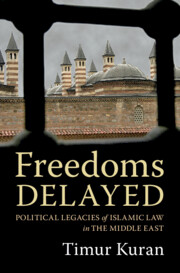Book contents
- Freedoms Delayed
- Freedoms Delayed
- Copyright page
- Dedication
- Contents
- Figures
- Tables
- Preface
- Part I The Modern Middle East’s Authoritarian Face
- Part II Persistent Social Atomization
- 3 Nongovernmental Organizations under Islamic Law
- 4 The Political Impotence of Islamic Waqfs
- 5 Waqf Corruption and Its Degradation of Civic Life
- 6 The Islamic Waqf’s Long Civic Shadow
- Part III Religious Repression
- Part IV Economic Hindrances
- Part V Conclusion
- Notes
- Bibliography
- Index
3 - Nongovernmental Organizations under Islamic Law
from Part II - Persistent Social Atomization
Published online by Cambridge University Press: 20 July 2023
- Freedoms Delayed
- Freedoms Delayed
- Copyright page
- Dedication
- Contents
- Figures
- Tables
- Preface
- Part I The Modern Middle East’s Authoritarian Face
- Part II Persistent Social Atomization
- 3 Nongovernmental Organizations under Islamic Law
- 4 The Political Impotence of Islamic Waqfs
- 5 Waqf Corruption and Its Degradation of Civic Life
- 6 The Islamic Waqf’s Long Civic Shadow
- Part III Religious Repression
- Part IV Economic Hindrances
- Part V Conclusion
- Notes
- Bibliography
- Index
Summary
Among the requirements of a liberal order is the ability to pursue collective goals through enduring private organizations. Such organizations contribute to political checks and balances, which sustain individual freedoms. In the Islamic Middle East, a possible starting point for autonomous nonstate organizations was the Islamic waqf, a trust that an individual formed under Islamic law to provide designated social services in perpetuity. Waqfs came to control vast resources. They might have used their enormous wealth to constrain the state and advance the freedoms of their constituents. The resulting decentralization of power could have placed the Middle East on the road to liberalization and perhaps also democratization. However, despite their immense wealth, waqfs remained politically powerless. A key reason is that they were governed according to their deeds, not the preferences of their caretakers or beneficiaries. In these respects, Islamic waqfs differed from European corporations, which were self-governing organizations enjoying legal personhood. In the Middle East, waqfs supplied services that the corporation provided in Western Europe. For instance, whereas churches and universities operated as corporations, mosques and madrasas (Islamic colleges) were financed by waqfs. This institutional difference contributed to the interregional divergence in political patterns.
Keywords
- Type
- Chapter
- Information
- Freedoms DelayedPolitical Legacies of Islamic Law in the Middle East, pp. 47 - 59Publisher: Cambridge University PressPrint publication year: 2023

